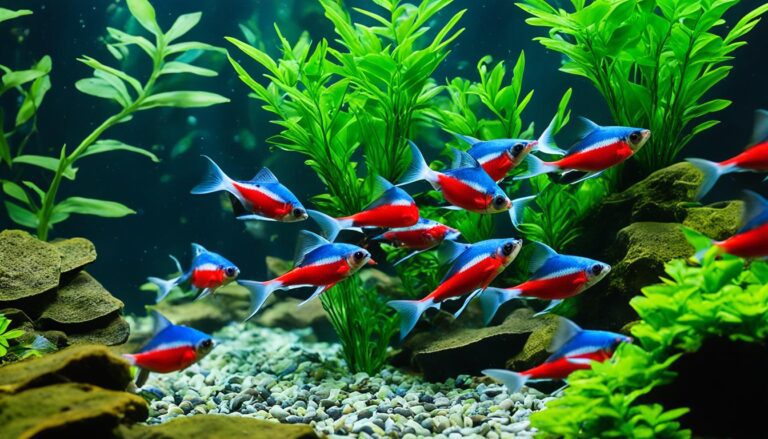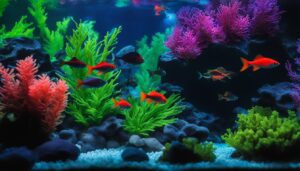Adding vibrant color and movement to an aquarium is captivating. Discovering Bleeding Heart Tetras was like finding treasure for me. These fish have a distinct heart-shaped mark on their sides. They come from South America’s calm streams. They mix beauty with tranquility, known for being peaceful yet colorful.
I’ve seen many bright fish, but Bleeding Heart Tetras stand out. They’re easy to care for with a little effort. They like to be in schools, swimming together gracefully. This makes them less stressed and is a beautiful sight. A detailed care guide is crucial for a beautiful aquarium.
They usually get along with other fish but can nip fins if not in big enough groups. A small group worked well in my 20-gallon tank. This keeps them happy and avoids problems. Both new and experienced keepers find Bleeding Heart Tetras charming and easy to care for.
Knowing about their natural environment and diet is important. Proper tank conditions help them live 3-5 years. A well-kept aquarium keeps them healthy. Next, we’ll explore how to make these fish thrive in your home aquarium.
Bleeding Heart Tetra Profile
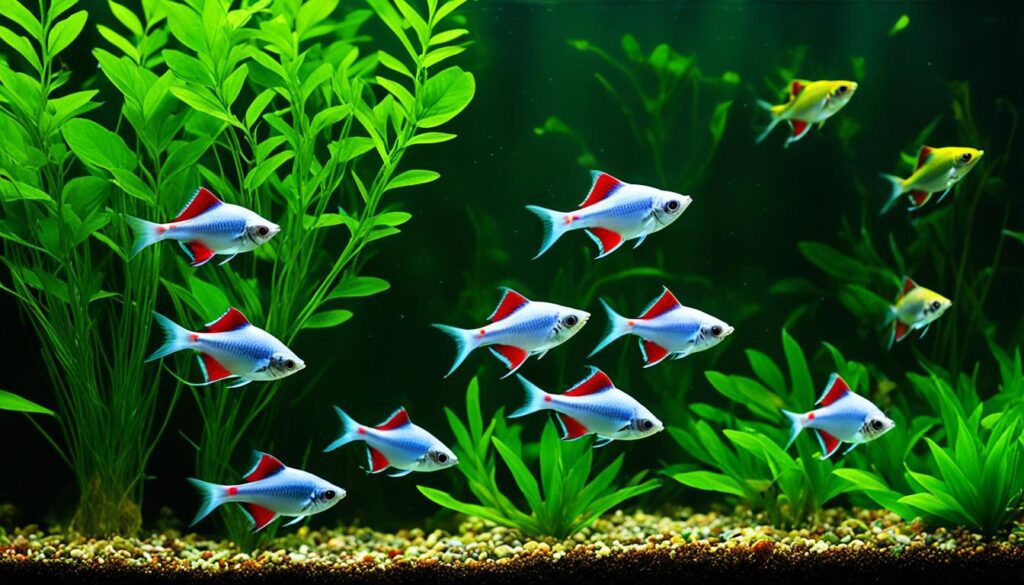
The Hyphessobrycon erythrostigma, known as the Bleeding Heart Tetra, is a favorite in the aquarium world. They come from the large rivers of Peru and Colombia. These fish are loved for their bright red patterns and calm ways.
They are also called the Red Tipped Tetra or Punto Rojo. These fish add color and life to tanks.
The ideal water pH for Bleeding Heart Tetras is between 6.5 and 7.5. They do best in temperatures from 72 to 82°F (22 to 27°C). They like environments that are similar to their home in South America, with lots of plants and soft, acidic water.
Keeping them in groups of five or more is crucial. They are shoaling fish and do well in a social setting.
Characteristic |
Detail |
|---|---|
Maximum Size |
8 cm (approximately 3 inches) |
Average Lifespan |
Up to 5 years |
Optimal pH Range |
6.5 – 7.5 |
General Hardness (GH) |
5 – 15 |
Total Dissolved Solids (TDS) |
50 – 150 |
Temperature Range |
72 – 82°F (22 – 27°C) |
Recommended Group Size |
5 or more |
Breeding |
Eggs hatch in 2 to 3 days |
Bleeding Heart Tetras are peaceful but can be shy. They might nip fins if their group is too small or if other fish are aggressive. Make sure they live with peaceful fish.
They need a tank with lots of space and places to hide. This helps prevent stress and aggression.
For those wanting to bring color and activity to their tank, the Hyphessobrycon erythrostigma is perfect. Proper care ensures this vibrant Red Tipped Tetra will thrive in a peaceful fish community.
An In-depth Guide to Bleeding Heart Tetra Care
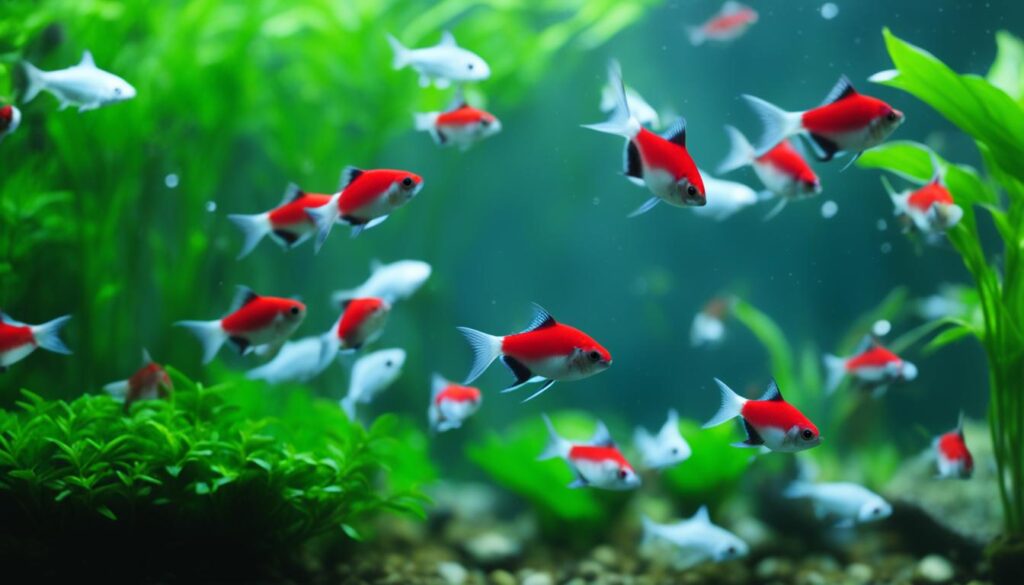
Caring for Bleeding Heart Tetras means knowing what they need. These fish stand out because of their heart marks and calm nature. They’re a favorite for fish lovers. This guide covers everything from tank mates to breeding.
Bleeding Heart Tetras love a home like the Amazon basin. They enjoy water that’s a bit acidic or neutral, with a pH of 5 to 7.5. They like it warm, between 73-82 °F. Keeping them healthy means changing water weekly and filtering it well.
For tank friends, Bleeding Heart Tetras like calm fish. Good buddies include Corydoras catfish, tiny gouramis, and other tetras. They feel best in groups of six or more. This keeps them from getting stressed and lets them act naturally.
- Feeding: They need a varied diet. Mix quality flakes or pellets with things like bloodworms.
- Breeding: It’s tough to breed these fish. Best to get advice from an expert for success.
Parameter |
Value |
|---|---|
Optimal Group Size |
Minimum of 6 |
pH Level |
5.5 – 7.0 |
Water Temperature |
72°F – 80°F (23°C – 28°C) |
Hardness |
3° to 12° dH |
Tank Size |
20 gallons or larger |
Looking after these steps will keep your Bleeding Heart Tetras in good shape. Plus, you’ll get to enjoy the peaceful beauty of these fish as they glide around in a well-kept tank.
The Habitat and Tank Conditions for Bleeding Heart Tetras
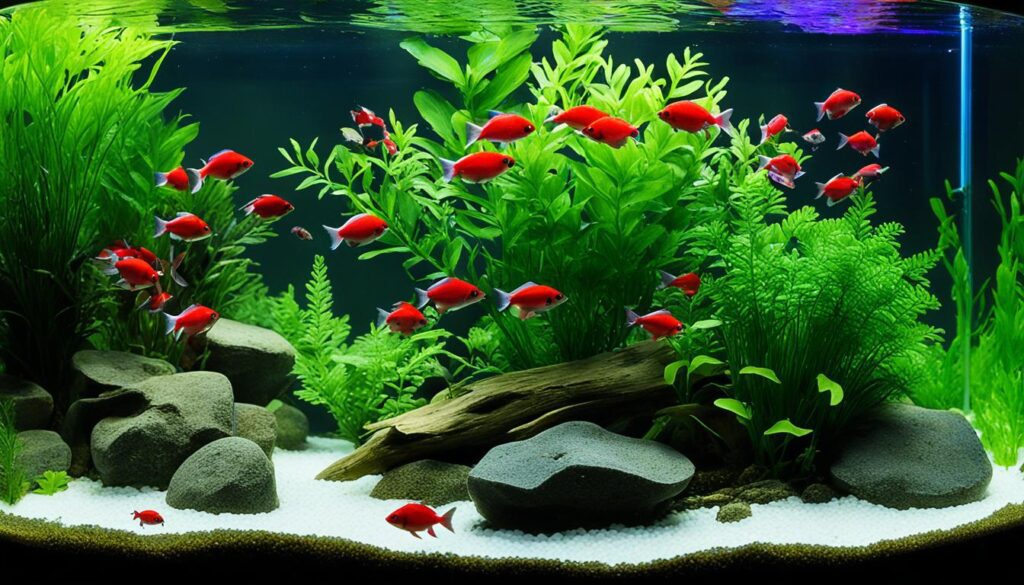
To make the perfect home for Bleeding Heart Tetra, bring their tropical world to your tank. You need the right water, plants, and a setup that feels like their home. All these help them stay healthy and happy in your aquarium.
Creating a Mini Ecosystem
To mimic their home in the Amazon, your tank should have soft sand and lots of plants. Add driftwood too. These create cozy hideouts and keep the tank stable, making your fish feel safe.
Optimal Water Parameters
Keeping the water just right is crucial. Keep the temperature between 72°F and 80°F. The pH level should be between 6.0 and 6.5. This keeps them in top shape.
Tank Setup and Decorations
The tank’s setup does more than look good. For a happy Bleeding Heart Tetra, get at least a 20-gallon tank. Plants are not just decor. They add oxygen and clean the water, too.
Filtering Techniques and Aquarium Maintenance
A good filter keeps the water clean and healthy. It takes out bad stuff and spreads the good. Keep your tank clean with regular water changes. This makes a perfect home for your fish.
Parameter |
Ideal Range |
Importance |
|---|---|---|
Temperature (°F) |
72 – 80 |
Regulates metabolic rates |
pH Level |
6.0 – 6.5 |
Ensures enzyme functionality |
Minimum Tank Size (Gallons) |
20 |
Allows adequate swimming space |
Focus on these key things to make a thriving place for your Bleeding Heart Tetras. They’ll be healthier, live longer, and show off their bright colors.
Feeding Your Bleeding Heart Tetra Correctly
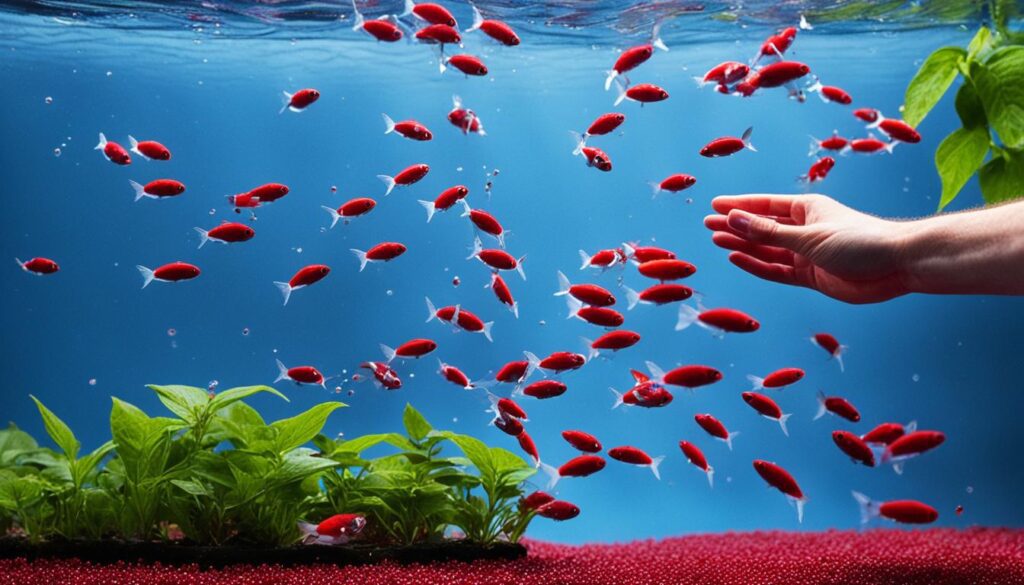
To keep your Bleeding Heart Tetras vibrant and healthy, know their feeding regimen well. Offer them plant-based and protein-based foods. This mirrors their natural eating habits.
Their main food should be top-notch flake or pellet food. This food gives them all the nutrition they need. But, don’t forget to add live or frozen treats like brine shrimp, bloodworms, and daphnia. This keeps mealtime fun for them.
Treats like these feed them well and keep them excited. Yet, it’s key to give them the right amount. Overfeeding can make them sick and harm the water. Aim to feed them in small amounts twice daily.
Food Type |
Benefits |
Frequency |
|---|---|---|
Flake or Pellet |
Main source of balanced nutrients |
Daily |
Brine Shrimp |
Enhances color and provides proteins |
2-3 times a week |
Bloodworms |
High in protein, favored treat |
2-3 times a week |
Daphnia |
Provides variety and aids in digestion |
1-2 times a week |
A diverse and nutritious meal plan keeps your fish healthy, active, and colorful. A well-looked-after fish brings life to your tank. Happy feeding!
Identifying and Preventing Common Health Issues

Caring for Bleeding Heart Tetra involves spotting health issues early on. To keep a thriving aquarium, it’s key to have optimal water conditions. It’s also important to know about illnesses and set up quarantine areas to improve the fish’s health.
Recognizing Early Signs of Illness
If your Bleeding Heart Tetras show signs like tiredness, odd swimming, pale colors, or spots, they might be sick. Watching them closely helps catch diseases early. This way, illnesses won’t spread much in the tank.
Common Diseases of Bleeding Heart Tetras
Stress and bad water quality make Bleeding Heart Tetras prone to sickness. They often get Aeromonas, Vibriosis, and Saprolegnia, which show as skin sores or fluffy growths. Treat them quickly with the right medicine to help them recover.
Health and Quarantine Protocols
Quarantine protocols are crucial to prevent diseases. Keep new fish in a separate tank for 2-3 weeks to check for illnesses. Keeping the water quality high, by checking pH, temperature, and ammonia, helps avoid diseases.
Parameter |
Optimal Range |
|---|---|
Tank Size |
Minimum 30 gallons |
Temperature |
72°F to 80°F (22°C to 27°C) |
PH Level |
6.0 to 7.5 |
Water Hardness |
5 to 15 dGH |
Nitrate Levels |
Below 20 ppm |
Ammonia and Nitrite Levels |
0 ppm |
To manage health issues well, follow these guidelines and watch your fish closely. Acting quickly when they first show signs of disease is key to keeping Bleeding Heart Tetras healthy and happy.
Behavioral Dynamics and Social Structure
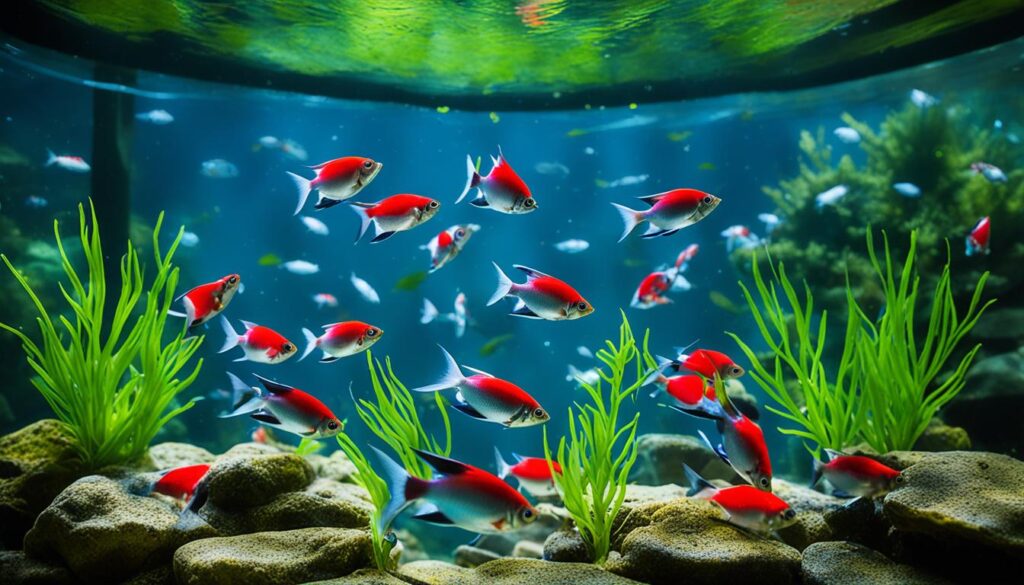
Understanding the social behavior of Bleeding Heart Tetras is key to a peaceful aquarium. These fish like to stay in groups and are known for being calm. Watching them move together in water not only shows their need to be in groups. It also helps them feel less stressed. This means they are less likely to nip at each other’s fins, a problem for those who have aquariums.
Keeping Bleeding Heart Tetras in groups of five or more is good for them. This keeps them from getting stressed and acting out. It also adds to the tank’s lively feel. They swim closely together, which is fun to watch and helps keep the tank’s environment stable.
The way schooling fish like Bleeding Heart Tetras stick together is not just nice to look at. It also helps them survive by avoiding predators and finding food better. In a tank, this leads to less fighting and a balanced home for all the fish. They play a big role in making the tank a peaceful place.
Fin nipping can happen if fish are stressed or don’t get to socialize enough. Having enough Bleeding Heart Tetras in the tank helps stop this from happening. They make the tank’s social life better, leading to a calm place where all fish do well.
By creating the right environment for these fish, aquarium lovers can see the best of their social ways. Bleeding Heart Tetras make a great addition to peaceful fish communities. They bring beauty and harmony to the tank.
Tips for Successful Reproduction
Raising Bleeding Heart Tetras, known as Hyphessobrycon socolofi, is rewarding. It starts with creating the right environment. The key is to make their tank similar to where they naturally spawn. I always make sure my tank is big enough before I start. For H. socolofi, tanks need to be at least 90 * 30 cm. This gives them space for courtship and lowers stress.
To get them ready to breed, I adjust the water temperature to 22 – 28 °C. This matches the warm water of their natural habitat. The water also needs to be soft, with hardness between 18 – 179 ppm. And, the pH should be a bit acidic, from 4.0 to 7.5. With these conditions, the tank is ready for breeding. Adding lots of plants or spawning mops is crucial. These fish spread their eggs among plants. Their eggs hatch in about 2-3 days. Then, I have to remove the adult fish to protect the fry.
Caring for the fry is next. They need the right food to grow. I start with infusoria or liquid fry food, then switch to micro worms and brine shrimp. Keeping a regular feeding schedule and a clean tank helps the fry thrive. Since they like being with others, I raise them in groups of six or more. This reflects their natural behavior and helps them stay happy.
